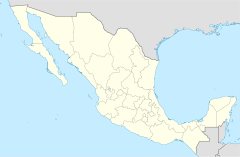Santiago Yaitepec facts for kids
Quick facts for kids
Santiago Yaitepec
|
|
|---|---|
|
Municipality and town
|
|
| Country | |
| State | Oaxaca |
| Area | |
| • Total | 53.58 km2 (20.69 sq mi) |
| Elevation | 1,840 m (6,040 ft) |
| Population
(2005)
|
|
| • Total | 3,665 |
| Time zone | UTC-6 (Central Standard Time) |
| • Summer (DST) | UTC-5 (Central Daylight Time) |
Santiago Yaitepec is a town and municipality located in Oaxaca, a state in southern Mexico. It is about two kilometers southeast of another town called Santa Catarina Juquila.
This area is part of the Juquila District, which is in the central part of the Costa Region. The name "Yaitepec" has a special meaning: it comes from a local language and means "Three hills."
Contents
Geography and Environment
Santiago Yaitepec covers an area of about 53.58 square kilometers. It sits high up, at 1,840 meters (about 6,037 feet) above sea level. The land here is very hilly, as it is located in the foothills of the Sierra Madre del Sur mountain range.
Climate and Weather
The climate in Santiago Yaitepec is mild and humid. The average temperature is around 17.9 degrees Celsius (about 64 degrees Fahrenheit). The area also gets a good amount of rain, with about 1,347.6 millimeters (around 53 inches) falling each year.
Plants and Animals
The forests around Santiago Yaitepec are home to many types of trees. You can find pine, fir, madrone, moral, oak, and alder trees.
The wild animals living here include opossums, skunks, armadillos, rabbits, snakes, and deer.
People and Culture
In 2005, Santiago Yaitepec had 623 households. The total population was 3,665 people. A large number of these residents, 3,137, spoke an indigenous language.
Daily Life and Economy
Most of the people in Yaitepec, about 90%, work in agriculture. Coffee is the main crop they grow to sell.
Santiago Yaitepec is an important center for the Chatino people. The Chatino are an indigenous group related to the Zapotec, but they have their own unique language.
Traditions and Governance
The municipality chooses its leaders using a system called "Uses and Customs." This system allows indigenous communities to keep their traditional ways of governing themselves.
Even though the town has modern services, the Chatino community has kept its traditional culture strong. Many women wear traditional clothing. This includes colorful skirts and blouses that are beautifully embroidered. These blouses often feature bright flowers and animals, showing off unique local designs. The clothes are made by hand using special looms and then embroidered by hand.
One interesting fact about the town is that it is "dry." This means that no alcohol is sold there.


